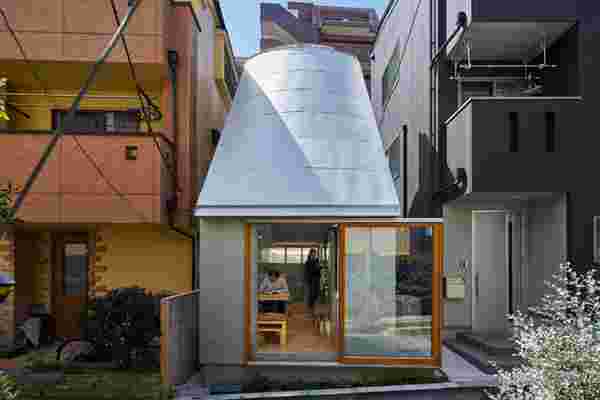
Moving to Tokyo with his wife, architect Takeshi Hosaka found a tiny nook of the urban world to build his modest, single-story, micro-home . The tiny home , called Love2 House occupies a total of around 30 meters of Tokyo pavement in the Bunkyo district, decreasing the total area of their previous living space by seven meters. Hosaka designed his Tokyo-based micro-home with both simple pleasure and realistic practicality in mind.
Inspired by Roman villas, Hosaka aimed to bring the restful repose that comes with country living to the city world, so he focused on how he could create a home that catered to studying, bathing, the theater, music, and gastronomy. The micro-home is equipped with a bathroom, which includes a toilet and washing area, a bedroom that shares an entry with a small, outdoor garden space, a practical kitchen area to concoct healthful meals, a study and dining table area for lounging or productivity, and finally a storage area where the laundry facilities and bulkier, electronic items are found. Love2 House embraces the natural bustle of the Tokyo lifestyle by easily slipping into a vacant alcove between two traditionally urban living spaces, and also encases a full, 19 meters of living space between its reinforced concrete walls. Crowning the concrete micro-home is the main event, Hosaka’s funnel-roof.
Hosaka had to prepare for three months of winter, during which his Love2 House would not receive any direct sunlight. Hosaka’s solution was a curved roof whose exposed vertex produced a pocket of skylight to fill up the single-story micro-home with plenty of natural bright light from the sun, no matter the season. On the winter daylight dilemma, Hosaka says, “In the winter, the two skylights effectively bring soft sunlight into the house and in the summer the house is filled with brilliant sunshine like in a tropical country.” The roof is also protected from weather changes and forces for the exterior panels are clad with galvanized aluminum, which helps preserve metallic surfaces from rusting due to corrosion and oxidation. The unexpected largeness of the micro-home comes through with the slightly curved, tall ceilings that seem to expand the entire floor space with lots of open-air and natural sunlight. While living in one of today’s busiest cities, Hosaka managed to attain the pleasures of country living by architecturally sculpting and designing both into and around the 30 meters of Tokyo pavement where Love2 House nestles.
Designer: Takeshi Hosaka
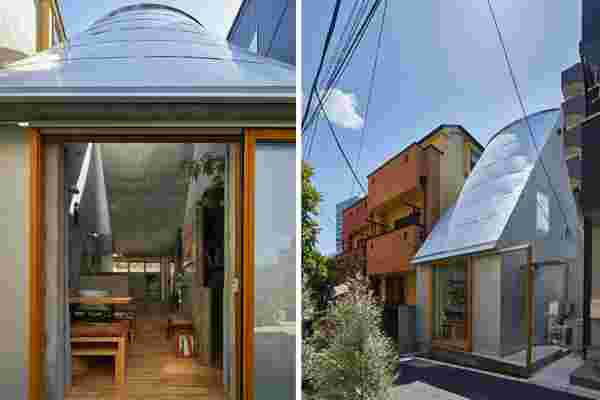
The rolling green roof of this modern art museum was built with to merge art preservation with futuristic technology!
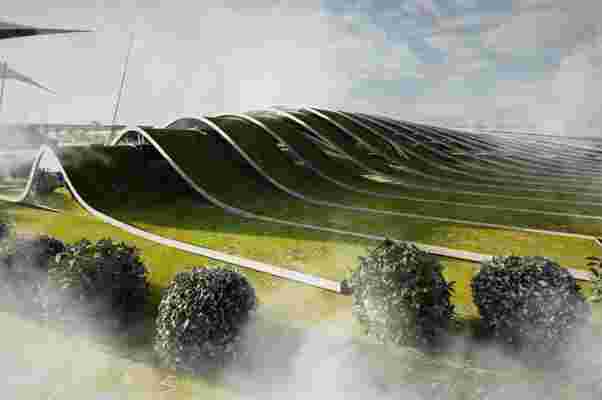
On one hand, museums are known for keeping paintings and artifacts of ancient civilizations with preservation being the goal. On the other, more modern museums incorporate some of the most advanced technology of today into their exhibitions to introduce the exciting possibilities for the art of tomorrow. Enacting his own preferred modern technology to conceptualize a modern art museum for the city of Tehran, architect Milad Eshtiyaghi hopes to evolve this relationship between today’s technology and the preservation of Islamic and Iranian art .
Known for designing bold, daredevil retreats stationed on the edge of mountain summits and cliffsides, Eshtiyaghi maintained the same mythical energy for his most recent rendering of Tehran’s Modern Art Museum. From an aerial viewpoint, Eshtiyaghi’s museum does not form any distinct shape, progressing past geometric, sharp angles for a gleaming white roof that slopes and bulges like a white tarp covering a wild landscape. Modern museums are generally known for their conceptual architecture, a form Milad Eshtiyaghi executes well considering his wide array of escapist hideaways. The green space that surrounds Eshtiyaghi’s museum tightens the museum’s abstract energy with rolling green roofs that mimic the overlapping lines of soundwaves, offering a place to rest on its manicured lawns.
Inside, the shapelessness of Tehran’s Modern Art Museum provides an eccentric stage for contemporary art exhibits. The museum’s tower wing spirals above the rest of the exhibition space, bringing guests to the museum’s highest vantage point via a web of winding, interconnected staircases. Etched along the tower’s facades and the museum’s main lobby, circular holes infuse the museum’s industrial interior with plenty of sunlight. Throughout the museum’s interior and exterior spaces, Eshtiyaghi hoped to communicate the significance of modern technology when used for art preservation, merging the age-old practice of museum work with today’s technological advancements.
Designer: Milad Eshtiyaghi
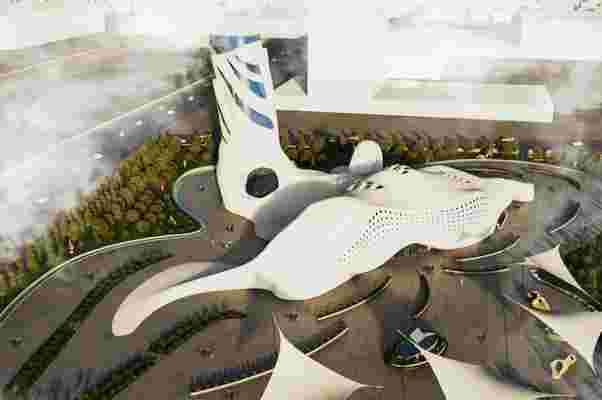
Without any distinct shape, Eshtiyaghi’s Modern Art Museum welcomes contemporary art, for all its abstract, shapeless glory.
Like many modern museum spaces, Eshtiyaghi’s Modern Art Museum features an outdoor plaza and interconnected green spaces.
Various vantage points puncture the museum’s facades.
The museum’s tower spirals above slopes and bulges of the museum’s white roof.
Holes are dotted across facades to bring in natural sunlight to the museum’s industrial interior.
Rolling green roofs mimic the flow of soundwaves.
Inside, staircases interconnect to form webs of walkways for guests to explore.
This tiny cabin features glazed glass walls to help you escape the city and connect with nature!
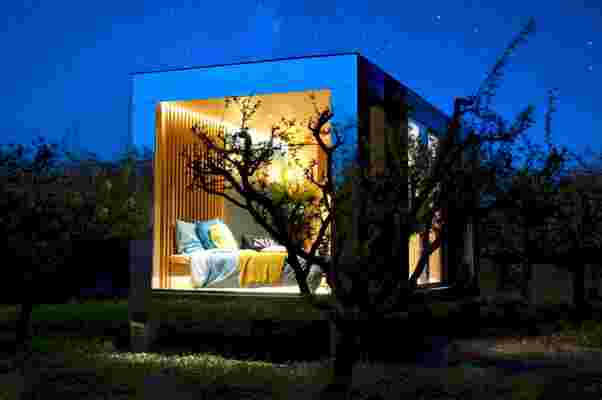
Working from home this past year has turned our houses into hybrids of the office and home– where we work is where we play is where we sleep. Many of us are finding isolated working zones, either through home renovation projects or tiny cabins devoted to work, to separate our days and keep work where it belongs. French architecture company Novablok is unveiling their take on the remote office and living space through a prefabricated tiny cabin called Mini Blok that can be positioned anywhere work calls us.
Mini Blok is a freestanding, simple cabin with a footprint of 21.6m2 that doesn’t require a permit to build or own. Without any foundation anchoring Mini Blok to the ground, the tiny cabin can be positioned in any location, from the backyard to a warehouse. With fully glazed walls, Mini Blok brings you up, close, and personal with nature. Novablok felt inspired to design their collection of tiny cabins, including Mini Blok, to create isolated spaces where working professionals and even individuals looking for a bit of a solitary respite can retreat and work or rest however they like. Tiny cabins are more popular than ever right now, for their low impact on the environment and escapist personalities. Mini Blok boasts a low carbon footprint and with such a sophisticated exterior and interior design, the workday might just end up becoming a work-cation.
The finishes and cladding of Mini Blok can be chosen from an array of different options. Constructed from natural and sustainable materials as part of Novablok’s commitment to maintaining the health of France’s forests, Mini Blok can be personalized from three different finishes. Brut is the barest option, delivering Mini Blok with only its frame and internal structuring for individuals to build and furnish the cabin however they like. The essential finish comes with interior wood paneling and built-in electrical networks but leaves the furnishing and interior design up to you. Finally, Mini Blok’s signature finish comes entirely furnished and fitted for electricity, water, and sewer systems. The exterior cladding can be chosen from Douglas fir, red cedar, or burnt wood created using the tried and true Japanese technique called Yakisugi.
Designer: Novablok
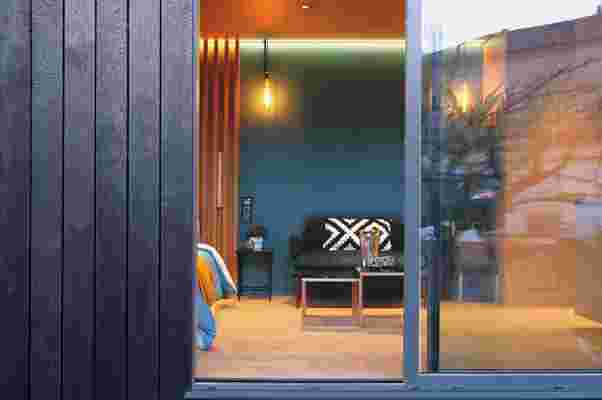
When buyers choose the signature finish for their Mini Blok, Novablok furnishes the interior and equips it with electricity and sewer systems.
Wood paneling and warm lighting gives Mini Blok an elegant feel and refined look.
Fully glazed, sliding glass doors build one facade of Mini Blok, dissolving the barrier between outdoor and indoor spaces.
Darker interior design elements are worked into the bathroom’s design through shadows and minimal paneling.
The different cladding finishes can be chosen from Douglas fir, red cedar, or Japanese burnt wood.
Clients can also reinforce the exterior of Mini Blok with composite material such as stone, concrete, and raw or painted sheet metal.
The Brut finish gives clients total freedom to design the inside and outside how they’d like.
Paneling and electricity are given to the Essential finish Mini Blok, leaving the interior design and furnishing up to you.
A signature finish comes completely prefabricated with sewer systems, electricity, and interior furnishing all taken care of.








